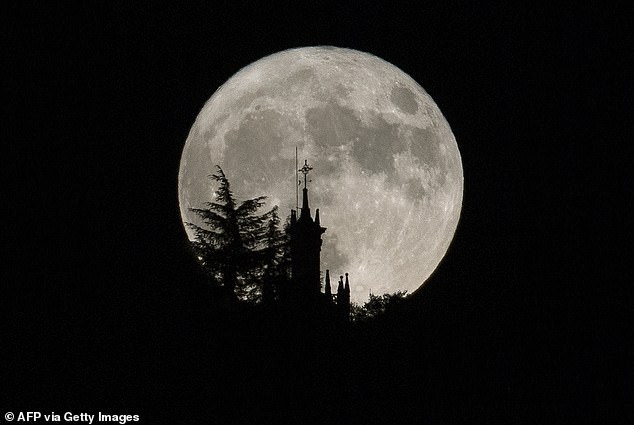A rare supermoon will light up the sky on Monday, appearing larger and brighter than any other moon seen this year.
The Sturgeon Moon will peak at 2:26 p.m. ET and remain full until Wednesday morning.
The name comes from the giant sturgeon of the Great Lakes and Lake Champlain, which is easily caught during the summer.
The celestial wonder also marks the start of a series of four consecutive supermoons this year.
The Super Sturgeon Moon will light up the night sky on August 19, followed by three more supermoons in a row in the following months.
‘This full Moon is the third of four that we will see during the current season. This type of full Moon is often called a Blue Moon, but of course this has nothing to do with the real color of our satellite,’ said astrophysicist Gianluca Masi, founder of the Virtual Telescope Project.
‘The last time, in 2021, there was a seasonal Blue Moon of this type and it will happen again in 2027.’
The term “supermoon” was coined by astrologer Richard Nolle in 1979 to refer to a new or full moon that occurs when the moon is 90 percent of its closest point to Earth.
The Moon is normally 238,900 miles from Earth, but on Monday it will be 224,917 miles away.
And because of its proximity, the Sturgeon moon will appear 14 percent larger and 30 percent brighter.
The sun sets around 7:30 p.m. ET, which will allow the moon to shine brightly in the night sky.
In the evening after sunset, look southeast to see the Sturgeon Moon rise.
On the East Coast, the supermoon will rise in eastern-southeastern skies, peaking about a third of the way across the sky before setting around 7 a.m. in the west-southwest.

An optical illusion makes supermoons appear larger and brighter when they are near the horizon.
If you live in the city, you may want to head outside for darker skies, as light pollution can dim the moon’s brightness.
To see the moon’s details up close, such as craters, be sure to bring binoculars and a telescope with you.
Although Native Americans generally refer to the August Supermoon as the “Sturgeon Moon,” the “Corn Moon,” the “Rice Moon,” and the “Black Cherry Moon” are other nicknames.
The Tlingit people of the Pacific Northwest traditionally called this time of season the Mountain Shadow Moon.
Meanwhile, the Anglo-Saxons also called it the ‘Grain Moon,’ according to Starwalk.
But if you miss this month’s supermoon, there will be three more in the coming months: one on September 18, another on October 17, and another on November 15.


